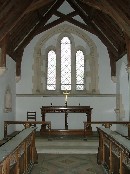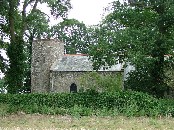| |
|
All
Saints, Barmer
 |
|
It
is a testament to the extraordinary record of
Billa Harrod's Norfolk Churches Trust that this
tiny church, lost in the fields near Fakenham,
has not only survived but prospered. There can be
no possible sensible economic reason for it still
to be with us - there is no village, and in any
case it had ceased to be parish church at the
Reformation. But here it is, a small
Victorianised Norman church hidden in a thick
copse of trees and entirely surrounded by fields,
a quarter of a mile or so from the nearest road. You need to
cross the fields to get to it, and although All
Saints is by no means the most remote church in
East Anglia from the nearest road, we didn't
think the track was driveable.
|
So we left
the car at the entrance to the field, hoping that we
weren't blocking the path of any tractors. In any case,
the field appeared to have been left fallow since the
harvest of the previous year's rape crop, leaving a wide
expanse of rigid, sharp stalks from which young rabbits
exploded as I tramped.
The Norman
round tower is visible from within the copse, but not
much else. In fact, work has started on trimming the
large trees in the graveyard, opening up new views,
especially from the east. The graveyard is still
overgrown with nettles and ground elder - I was glad I'd
worn sensible shoes.
There is a
crispness to the building which becomes apparent as you
approach, a reminder that All Saints was, in fact, a ruin
for three centuries.
| Then,
in 1885, the Kerslake family, who owned the land,
decided to restore it as a mausoleum in the
fashion of the day. This meant engaging London
architect Frederick Preedy, who rebuilt the north
aisle in a Decorated style and added an Early
English chancel for the sum of £650, about
£100,000 in today's money. Not bad, for
rebuilding a church. The
building you step into today is still entirely
Preedy's work. It is not without character; the
tympanum above the door is made of cast iron, and
Preedy's imitation medieval ironwork on the
Priest door is also worth a look.
|
|
 |
All Saints is kept open for
visitors, and you step into a simple, plain 19th century
interior. There are no great medieval survivals - how
could there be, for it was a ruin from the Reformation
onwards. The chancel arch and tower arch both survive
from the original Norman church, but have been altered at
some time to be pointed. Was this done in the 13th
century, or was it Preedy's work? It is in keeping with
his chancel, but of course he might have chosen that
style to fit in with the rest of the church.
The
Victorian furnishings have been replaced by modern
chairs, which creates a sense of space and allows
Preedy's font to dominate the little nave. If you look up
the tower, you can see the single bell.
    
There are
no major Kerslake memorials, just a ledger stone set
below the tower arch, recording deaths over a period of a
century or so. It must have been written in retrospect,
but it makes poignant reading. For example, the deaths of
three young brothers is recorded in 1815. John was six,
Samuel was three, Francis was just one year old.
| No
more than the bare facts, but you have to wonder
what happened. An infectious disease seems most
likely, of course: measles, perhaps, or scarlet
fever. Or perhaps it was an accident. How
heart-breaking! The bareness of the church makes
the inscription seem all the more stark. As this
church was in Syderstone parish, it came in for
occasional parochial use, but was finally
declared redundant in the 1970s. In the great
scheme of things it had existed as a church for a
fleeting moment, and even then had been of small
consequence. Quiet, small, lonely in the fields,
it was exactly the kind of church that the
Norfolk Churches Trust loved. The area around
Fakenham has the greatest concentration of ruined
medieval churches in England; but All Saints was
not to become one of them.
|
|
 |
|
|
|








